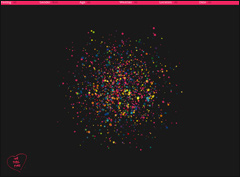
Image Credit: We Feel Fine
H/T: Stephanie Rosen
I spent an inordinate amount of time today on Jonathan
Harris and Sep Kamvar’s thought-provoking website, We Feel Fine. This website scans, or in their words “harvests,” weblogs for statements with the phrase “I feel.” Each of these statements is then
represented as a colorful “particle” and organized into a variety of visual and
statistical data. The website
generates fascinating examples of how people communicate about feelings and
gives a powerful impression of both the diversity and similarity among
affective statements online. It
also raises important questions about privacy. The statements and images on We Feel Fine are from blogs,
MySpace and Flickr. Harvested statements whose writers’ also posted images are represented as a
“Montage” with the text embedded in the image. Site users can then save and send these postcard-like
pieces. For both its creative design and surveillance techniques, We
Feel Fine provokes interesting questions regarding affect, privacy and
online writing.
Recent comments
2 years 29 weeks ago
2 years 44 weeks ago
2 years 44 weeks ago
2 years 50 weeks ago
3 years 4 weeks ago
3 years 4 weeks ago
3 years 4 weeks ago
3 years 6 weeks ago
3 years 6 weeks ago
3 years 6 weeks ago